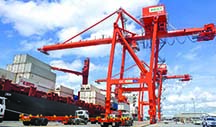 Throughput at Davao International Container Terminal (DICT) reached 228,000 twenty-foot equivalent units (TEUs) in 2014, 5% short of its 240,000-TEU target.
Throughput at Davao International Container Terminal (DICT) reached 228,000 twenty-foot equivalent units (TEUs) in 2014, 5% short of its 240,000-TEU target.
“For the year 2015, we look forward to hitting 250,000 TEUs,” Bonifacio Licayan, assistant general manager of San Vicente Terminal and Brokerage Services, Inc. (SVTBSI), told PortCalls in an email. This is equivalent to 72.5% of the terminal’s annual capacity of 345,000 TEUs.
The container terminal in Panabo City, Davao Del Norte was established by SVTBSI, a member of the Anflocor Group of Companies, in partnership with two of the country’s top exporters of Cavendish bananas—Tagum Agricultural Development Corp. and Dole Stanfilco.
DICT received its first vessel in May 2013 and, in the first seven months of operations, handled 18,287 TEUs and 39 vessels.
By 2014, the port was handling five international shipping lines —Pacific International Lines, ACL/RCL, APL, CMA CGM, and Wan Hai Lines—calling weekly, up from three shipping lines in 2013. By the end of February this year, DICT expects CMA CGM to add another service to bring its calls to twice weekly, according to Licayan.
Two reach stackers, two empty container handlers, four terminal tractors with bomb carts, and 360 reefer plugs became operational last year. And now the port has three reach stackers, five empty container handlers, and 18 terminal tractors/prime movers with bomb carts/trailers, Licayan said. The reefer plugs have also increased from 720 to 1,080.
Refrigerated facilities are especially crucial because DITC is at the crossroads of major agricultural plantations. Majority of port users are exporters of fresh produce — such as bananas and pineapples — and related industries, requiring reliable reefer facilities, Licayan said.
An additional 2-by-2.5 MVA standby gensets have been installed, bringing the port’s total standby capacity to 10 MVA.
“This ensures that critical port operations (such as quay cranes, reefer plugs, and terminal operating systems) will continue to operate even if the grid is totally down,” Licayan said.
To accommodate the increasing volume of empty containers, Licayan said the port’s 2.7-hectare empty container depot, located 400 meters from the port and now in full operation, will be expanded to another 5 hectares.
The consolidation area for the use of small growers and consolidators has increased the capacity to 52 reefer containers equipped with reefer plugs.
“We believe the cost of doing business in DICT is very advantageous to exporters and importers alike due to the efficiency of port operations, the predictability and consistency of ship calls, and the proximity of the port to most of the exporters/importers,” Licayan said.
“On top of that, DICT continues to charge very reasonable rates. Since the start of operation, DICT has not increased its port tariff,” he noted. – Roumina Pablo
Photo courtesy of DICT




